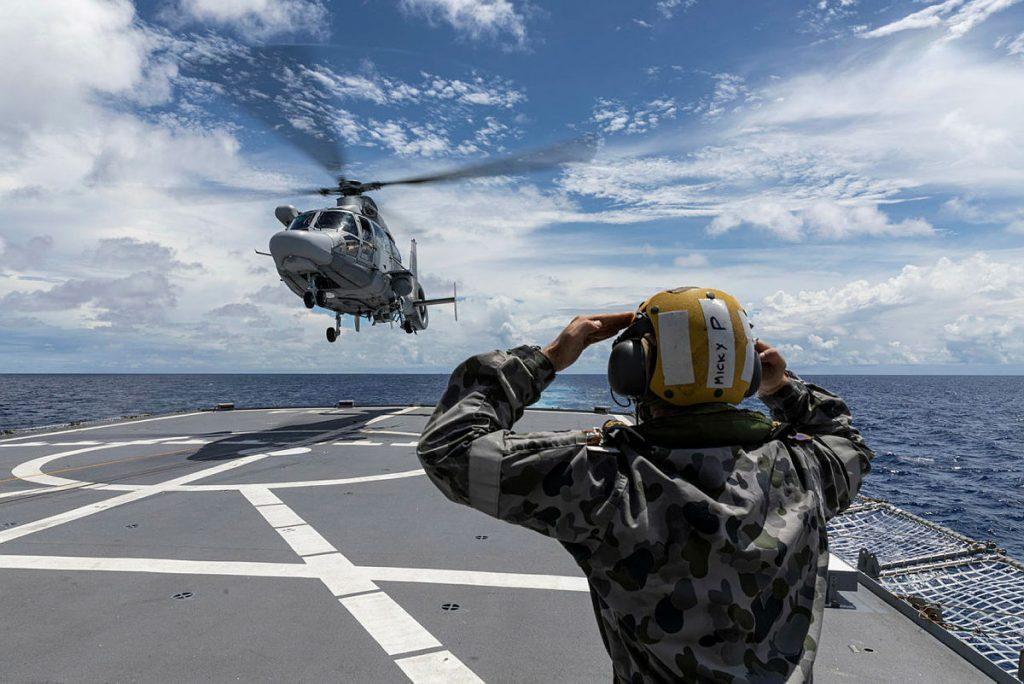
France’s strategy in the Indo-Pacific takes place in a context of regional political, economic and strategic re-engagement that dates back to the early 1990s. This has enabled France to develop a policy of partnerships legitimising its place and role as a power that’s both global and a riparian Indo-Pacific state. Until the mid-2010s, it took place in a permissive context in which the US appeared to be the undisputed dominant power of a vast region from the Eastern Pacific to the Arabian Gulf. It was essentially the rise of China and the assertive policy led by Xi Jinping, combined with the erosion of American dominance and leadership, that led France to develop a real strategy in the Indo-Pacific. The policy’s implementation relied upon strengthening cooperation with France’s major strategic partners in the region, in particular Australia, India and Japan, as well as on its overseas territories in the Indian and Pacific oceans.
The broad outlines of this strategy have many points in common with those developed by France’s major partners, particularly with regard to free access to contested global commons and the rejection of any hegemonism, but it’s nearly unique in its insistence on the importance of multilateralism, from the fight against climate change to France’s refusal to direct its strategy ‘against’ a state. Indeed, as the EU stated in March 2019, China is seen as a cooperative partner, a competitor and a systemic rival when promoting alternative governance models. But what differentiates the European and French approaches is that France has a significant territorial, human and military presence in the Indo-Pacific, which increases the stakes and France’s potential for action.
The political statutes of the départements (Réunion and Mayotte) and the overseas collectivities (New Caledonia, French Polynesia, Wallis and Futuna Islands) are different: the former are inalienable parts of the national territory, while the latter have very broad autonomy, to possibly evolve until independence as far as New Caledonia is concerned. Consequently, the policy led by Paris can’t be articulated in exactly the same way, even if the desire to promote the integration of those territories into their regional areas is common to all.
French policy in the Indo-Pacific is therefore partially contingent on the evolution of its territories on the statutory level and their will and capacity to be relays for regional action in Paris. Their low economic, energy and food autonomy is unlikely to change in the short or medium term, while their defence and security remain the exclusive responsibility of mainland France. On the military level, France’s pre-positioned capabilities are just sufficient to ensure the missions of sovereignty and in its regional cooperation activities, Paris seeking to compensate for its limits, notably by the development of long-distance air and naval projection capacities.
It’s certainly in terms of its economic presence and official development assistance (ODA) commitment that the French strategy suffers from the most significant limitations, which may nevertheless be offset by a growing commitment from the EU. The EU strategy for cooperation in the Indo-Pacific region, which should be released in September 2021, may ease that pressure. Indeed, in a context of multiple and heavy external commitments (in Europe, Africa and the Near and Middle East), France can’t engage more in the Indo-Pacific other than through strategic partnerships allowing it to pool efforts at all levels (political, military, economic) to meet China’s and global challenges (climate change, environmental protection, health, terrorism, piracy, cybersecurity and so on).
By proposing the construction of an ‘Indo-Pacific axis’ to his Indian and Australian partners, President Emmanuel Macron aimed to highlight the potential for trilateral cooperation in the region, in particular in the Indian Ocean, taking into account the French overseas territories and their fragile neighbourhoods. One of the main tools at France’s disposal is to contribute to the construction of a regional political and security architecture to better respond to challenges by promoting the development of the capacities of vulnerable countries, particularly in the regions surrounding its overseas territories.
Among the avenues for progress, Australia could consider taking up observer status at the Indian Ocean Commission, as that subregional cooperation platform is likely to play an increasing role in development, environmental protection and maritime security. Australia could also share its experience gained from the Pacific Fusion Centre, with a view to the centre’s possible duplication in the southwest Indian Ocean, and consider having a liaison officer at the Madagascar-based Regional Maritime Information Fusion Center (a body supported by the Indian Ocean Commission and responsible for maritime domain awareness in the Western Indian Ocean).
France became a full member of the Indian Ocean Rim Association in December 2020, so exchanges with France could develop in that context, so that the association becomes a place of exchange and cooperation on climate and security issues. Finally, in its development assistance policy, Australia could consider increasing ODA directed to East African states bordering the Indian Ocean, while the strengthening of France’s development assistance in the South Pacific could possibly involve the conclusion of a partnership agreement between the French Development Agency and the Australian Department of Foreign Affairs and Trade.
This is an excerpt from ASPI’s latest Strategy report, France’s Indo-Pacific strategy and its overseas territories in the Indian and Pacific oceans: characteristics, capabilities, constraints and avenues for deepening the Franco-Australian strategic partnership, released today.